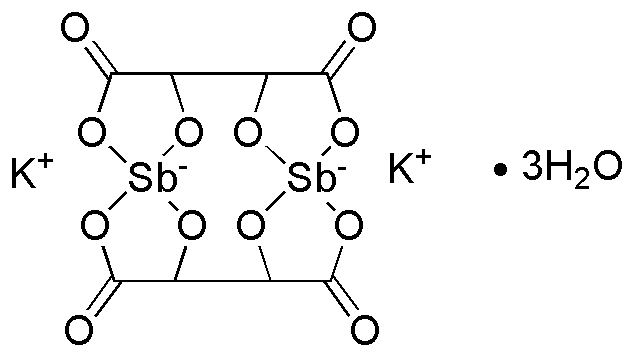Potassium antimonyl tartrate trihydrate is widely utilized in research focused on:
- Analytical Chemistry: This compound serves as a reagent in various analytical techniques, helping to detect and quantify antimony in environmental samples.
- Pharmaceutical Development: It is used in the formulation of certain medications, particularly in the treatment of parasitic infections, showcasing its efficacy in the pharmaceutical industry.
- Biochemistry: Researchers utilize it in biochemical assays to study enzyme activities and metabolic pathways, providing insights into cellular functions.
- Material Science: The compound is employed in the synthesis of antimony-based materials, which are useful in electronics and optics due to their unique properties.
- Environmental Monitoring: It plays a role in assessing the presence of antimony in soil and water, aiding in environmental protection efforts and compliance with regulations.
General Information
Properties
Safety and Regulations
Applications
Potassium antimonyl tartrate trihydrate is widely utilized in research focused on:
- Analytical Chemistry: This compound serves as a reagent in various analytical techniques, helping to detect and quantify antimony in environmental samples.
- Pharmaceutical Development: It is used in the formulation of certain medications, particularly in the treatment of parasitic infections, showcasing its efficacy in the pharmaceutical industry.
- Biochemistry: Researchers utilize it in biochemical assays to study enzyme activities and metabolic pathways, providing insights into cellular functions.
- Material Science: The compound is employed in the synthesis of antimony-based materials, which are useful in electronics and optics due to their unique properties.
- Environmental Monitoring: It plays a role in assessing the presence of antimony in soil and water, aiding in environmental protection efforts and compliance with regulations.
Documents
Safety Data Sheets (SDS)
The SDS provides comprehensive safety information on handling, storage, and disposal of the product.
Product Specification (PS)
The PS provides a comprehensive breakdown of the product’s properties, including chemical composition, physical state, purity, and storage requirements. It also details acceptable quality ranges and the product's intended applications.
Certificates of Analysis (COA)
Search for Certificates of Analysis (COA) by entering the products Lot Number. Lot and Batch Numbers can be found on a product’s label following the words ‘Lot’ or ‘Batch’.
*Catalog Number
*Lot Number
Certificates Of Origin (COO)
This COO confirms the country where the product was manufactured, and also details the materials and components used in it and whether it is derived from natural, synthetic, or other specific sources. This certificate may be required for customs, trade, and regulatory compliance.
*Catalog Number
*Lot Number
Safety Data Sheets (SDS)
The SDS provides comprehensive safety information on handling, storage, and disposal of the product.
DownloadProduct Specification (PS)
The PS provides a comprehensive breakdown of the product’s properties, including chemical composition, physical state, purity, and storage requirements. It also details acceptable quality ranges and the product's intended applications.
DownloadCertificates of Analysis (COA)
Search for Certificates of Analysis (COA) by entering the products Lot Number. Lot and Batch Numbers can be found on a product’s label following the words ‘Lot’ or ‘Batch’.
*Catalog Number
*Lot Number
Certificates Of Origin (COO)
This COO confirms the country where the product was manufactured, and also details the materials and components used in it and whether it is derived from natural, synthetic, or other specific sources. This certificate may be required for customs, trade, and regulatory compliance.


